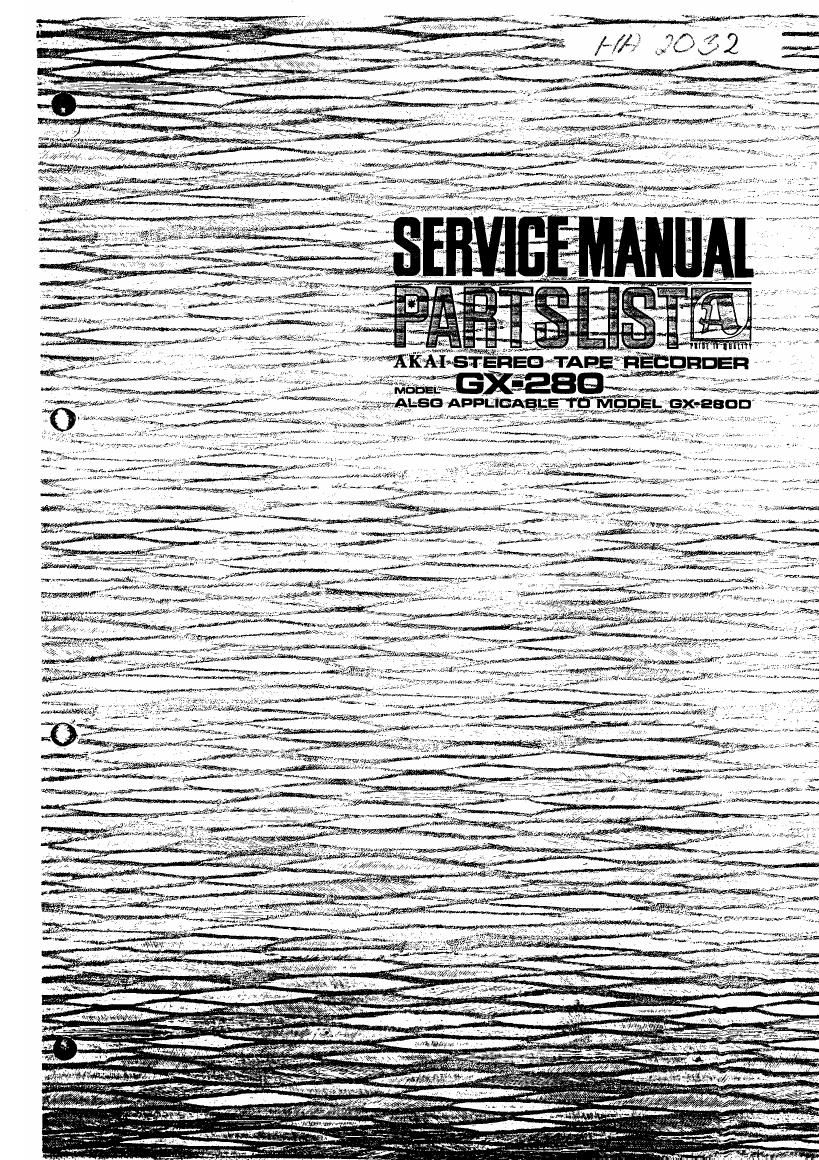Akai GX 280 D Service Manual
This is the 67 pages manual for Akai GX 280 D Service Manual.
Read or download the pdf for free.
If you want to contribute, please mail your pdfs to info@audioservicemanuals.com.

Extracted text from Akai GX 280 D Service Manual (Ocr-read)
Page 2
STEREO TAPE RECORDER
MODEL GX-280
ALSO APPLICABLE TO MODEL GX-280D
STEREO TAPE DECK
SECTION 1 SERVICE MANUAL ........................ 3
SECTION 2 PARTS LIST ............................. 35
SECTION 3 SCHEMATIC DIAGRAM .................... 64
Page 4
I. SPECIFICATIONS
An asterisk next to a figure indicates the minimum guaranteed performance,
TRACK SYSTEM 4 track/2 channel stereo/monaural system
REEL CAPACITY Up to 7" reel
TAPE SPEED 7-1/2 ips (19 cm/sec.) 10.5%(*1'0.5%)
3-3/4 ips (9.5 cm/sec.) 10.5%(*i1.0%)
Vow AND FLU'ITER Less than 0.08%(*0.12%) R.MIS. at 7-1/2 ips
Less than 0.12%(*0.l8%) R.M.S. at 3-3/4 ips
FREQUENCY RESPONSE S.R.T. Tape 30 to 26,000 Hz '13 dB at 7-1/2 ips
30 to 22,000 Hz is dB at 3-3/4 ips
Standard Tape 30 to 24,000 Hz (30 to 22,000 1-12) 13 dB at 7-1/2 ips
30 to 19,000 Hz (30 to 18,000 Hz) 1: dB at 3-3/4 ips
SIGNAL TO NOISE RATIO Better than 50 dB
*Better than dB at 7-1/2 ips
Better than 46 dB at 3-3/4 ips
DISTORTION FACTOR Less than 1.59173! 1,000 Hz 0 'VU recording
*Less than 2% at 7-1/2 ips 1,000 Hz 0" VU recording
*Less than 3% at 3-3/4 ips 1,000 Hz "0" VU recording
CROSS TALK Better than 70 dB("60 dB) monaural
Better than 50 (113043 dB) stereo
ERASE RATIO Better than 70 dB
BIAS FREQUENCY 100 to 110 kHz
BIAS LEAK Less than -20 VU
HIGH FREQUENCY DEVIATION
Between Channels
Within 2 dB, using an 8,000 Hz 3-3/4 ipsrecorded tape at 7-1/2 ips
Between FWD/REV Within 3 dB, using an 8,000 Hz 3-3/4 ips recorded tape at 7-1/2 ips
RECORDING/PLAYBACK LEVEL 0" VII $1.5 dB
INPUTS Mic Input 08 mV Impedance: 10 kn
Line Input 150 mV Impedance: 150 kn
12 mV(Iow), 75 mV(high)
Impedance: 68 kn
ou-mrrs Line Output 1.2st (4 11.5 as)
Din Output 0.4V
Power Output 20W continuous power at 89 (GK-280 only)
*10W when operating 1 channel at 89 (OX-280 only)
*SW at 89 distortion less than 0.5% (GK-280 only)
HUM AND NOISE Less than 3 mV at 89 VR min, Tone flat (GX-280 only)
TONE CONTROL Bass 14 i2 (18, -11 12 dB at 100 Hz
Treble 15 i2 :13, -14 12 dB at 10,000 Hz
RECORDING CAPACITY 60 min. stereo recording, using a 1,200 ft. tape at 7-1/2 ips (19 cut/see)
FAST FORWARD AND REWIND TIME
MOTORS Capstan Motor
Reel Motor
Erase Head
HEADS
Recording Head
Playback Head
64/80 sec., usinga 1,200 ft. tape at 60/50 Hz
2-speed servo control outer rotor motor
Type: SCM2-24
Revolutions: 520 r.p.m. at 7-1/2 ips (19 (rm/see)
260 r.p.m. at 36/4 ips (9.5 cm/sec.)
Two 6
Revolutions: 930 r.p.m. at 50Hz
1,120 r.p.m. at 60 Hz
Type: 134-250
Gap: 0.6mm
Impedance: 19511 110% atIOO kHz
00 Resistance: 3.5.0
Type: R4-200
Gap: 4].: 115%
Impedance: 1,8709 at 100 kHz
D.C. Resistance: 89
Type: Pit-200
Gap: 1.759 $1596
Impedance: 3 :1 kn at 1 kHz
D.C. Resistance: soon
Page 6
II. MEASURING METHOD
l. TAPE SPEED DEVIATION
F Frequency
counter
GX-280
: Line output ,
input
As shown in Fig. 1, connect a Frequency Counter
to the Line Output of Model GX-280. Playback a
1,000 Hz pre-recorded test tape. Take a Frequency
Counter reading at the beginning, middle, and end
of tape winding during playback. The maximum
value of these respective readings will represent
tape speed deviation.
Fig. l
2. WOW AND FLUITER
GX-280 Wow and Flutter
Line output , Meter input
%
Fig. 2
Method A
As shown in Fig. 2, connect the Line Output of
Model GX-280 to the Input of a Wow and Flutter
Meter. Playback a 3,000 Hz pre-recorded test tape
and take a Wow and Flutter Meter reading at the
beginning, middle, and end of tape winding. The
maximum value of these respective readings will
represent the Wow and Flutter.
Method B
Supply a 3,000 Hz sine wave signal from an Audio
Frequency Oscillator and make a recording on a
blank tape at the beginning, middle, and end of
tape winding. Rewind and playback the resultant
signal. Measure Wow and Flutter with 3 Wow and
Flutter Meter. (The Wow and Flutter value of
Method B will be close to twice that of Method A.)
3. FREQUENCY RESPONSE
Audio t Li GX-280
Frequency ou '_ A.T.T. -. ne
Oscillator ut _ - "1pm Line
output
High Sensitivity
V.T.V.M.
Fig. 3
For measuring Frequency Response, connect instruw
ments as shown in Fig. 3 and proceed as follows:
1) Supply a 1,000 Hz sine wave signal to the
Line Input of Model GX-280 from an Audio
Frequency Oscillator through an Attenuator.
2) Set recorder to recording mode and turn recording
level control volume and line output level control
volume to maximum. Adjust attenuator to obtain
a +4 dB V.T.V.M. reading.
3) Under conditions described in 2) above, readjust
attenuator so that the Line Output is -16 dB,
and record 30 to 24,000 Hz spot frequencies.
4) Rewind tape and playback from the beginning.
Take V.T.V.M. spot frequency readings and plot
values on a graph.
NOTE: When measuring Frequency Response, new
tape should be used.
4. SIGNAL T0 NOISE RATIO
GX~280
Line output
High Sensitivity
V.T.V.M.
Fig. 4
As shown in Fig. 4, connect a High Sensitivity
V.T.V.M. to the Line output of Model (DC-280.
Playback a 250 Hz 0 VU pre-recorded test tape
and measure the output. Then remove the tape
and measure the noise level under the same condi-
tion. Convert each of the measured values into
decibels.